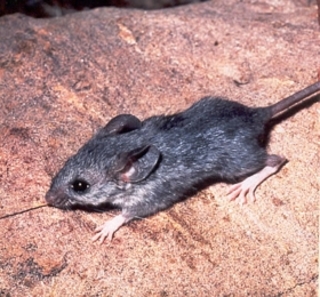
Cactus mouse
Order : Rodentia
Suborder : Sciurognathi
Family : Muridae
Subfamily : Sigmodontinae
Species : Peromyscus eremicus
The Cactus mouse is listed as Least Concern (LR/lc), lowest risk. Does not qualify for a more at risk category. Widespread and abundant taxa are included in this category, on the IUCN Red List of Threatened Species
Namings for the cactus mouse
A young / baby of a cactus mouse is called a 'pinkie, kitten or pup'. The females are called 'doe' and males 'buck'. A cactus mouse group is called a 'nest, colony, harvest, horde or mischief'.Some facts about the
Cactus mouse
Adult weight : 0.025 kg (0.055 lbs)
Maximum longevity : 7 years
Female maturity :129 days
Gestation : 26 days
Weaning : 25 days
Litter size : 3
Litters per year : 4
Interval between litters : 39 days
Weight at birth : 0.002 kg (0.0044 lbs)
Body mass : 0.021 kg (0.0462 lbs)
Temperature : 36.85 °C (98.33 °F)
Facts about the cactus mouse
1993: Cactus mouse is rare in the White Sands National Monument (White Sands NM, 1993) *15*.
Cactus Mouse or Peromyscus eremicus is listed on the IUCN Red list (1996) as Lower Risk/Least Concern .
Food Habits The cactus mouse is an omnivore and is believed to be an opportunistic eater.
Peromyscus eremicus is .
Reproduction The gestation period for Peromyscus eremicus is twenty-one days.
The cactus mouse is found in western and southwestern Arizona.
The cactus mouse is one species of a closely related group of common mice often referred to as "deer mice".
The cactus mouse is only about 3 inches long, has large ears and feeds on seeds, fruits and juicy plants.
The cactus mouse, Peromyscus eremicus, is a grayish-brown mouse native to parts of the southwestern United States and Mexico. (Full text)
Our Cactus Mouse is well known for its adherence to the rocky lower slopes of our Chihuahuan Desert mountain ranges; so much so, that we can predict their presence with considerable certitude. (Full text)
NATURAL HISTORY In captivity, Peromyscus eremicus is typically described as docile, quiet, and shy, yet excitable; they seldom attempt to bite when handled (Svihla, 1932; Brand and Ryckman, 1968; Murie, 1961). (Full text)
The Cactus Mouse is from the order Rodentia. (Full text)
More animals beginning with C
